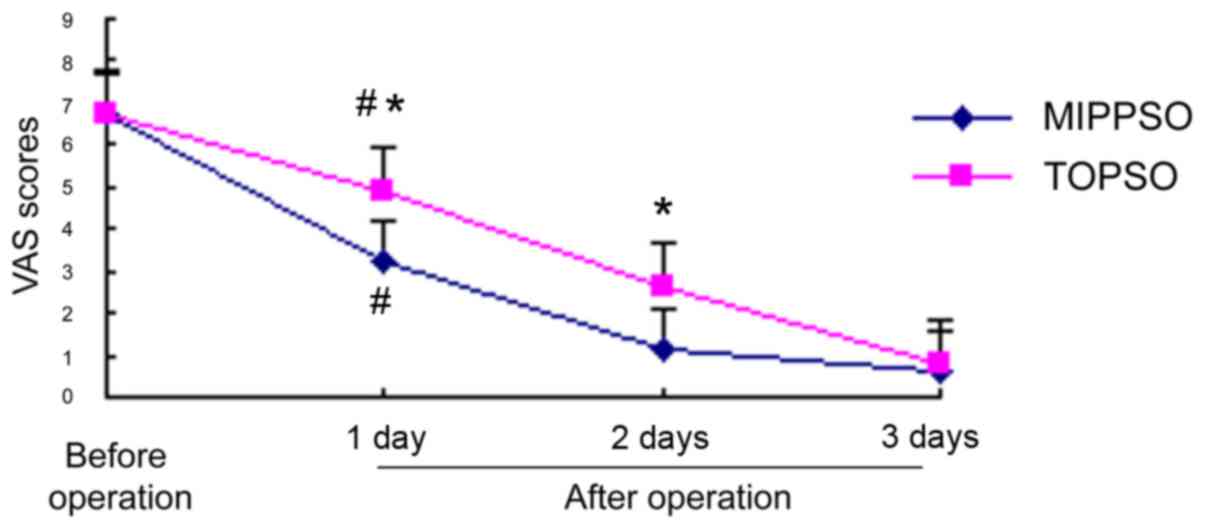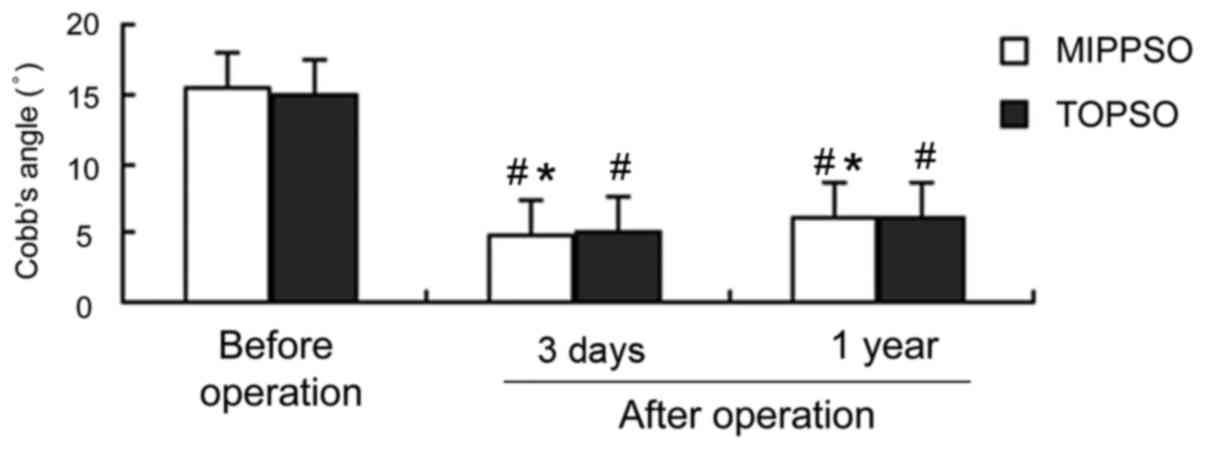|
1
|
Zairi F, Aboukais R, Marinho P, Allaoui M
and Assaker R: Minimally invasive percutaneous stabilization plus
balloon kyphoplasty for the treatment of type A thoraco lumbar
spine fractures: Minimum 4 year's follow-up. J Neurosurg Sci.
58:169–175. 2014.PubMed/NCBI
|
|
2
|
Alizadeh M, Kadir MR, Fadhli MM,
Fallahiarezoodar A, Azmi B, Murali MR and Kamarul T: The use of
X-shaped cross-link in posterior spinal constructs improves
stability in thoracolumbar burst fracture: A finite element
analysis. J Orthop Res. 31:1447–1454. 2013. View Article : Google Scholar : PubMed/NCBI
|
|
3
|
Kim DY, Lee SH, Chung SK and Lee HY:
Comparison of multifidus muscle atrophy and trunk extension muscle
strength: Percutaneous versus open pedicle screw fixation. Spine.
30:123–129. 2005. View Article : Google Scholar : PubMed/NCBI
|
|
4
|
Magerl F: External skeletal fixation of
the lower thoracic and the lumbar spineCurrent Concepts of External
Fixation of Fractuers. Unthoff HK and Stahl E: Spring Verlag; New
York, NY: pp. 353–366. 1982, View Article : Google Scholar
|
|
5
|
Grossbach AJ, Dahdaleh NS, Abel TJ, Woods
GD, Dlouhy BJ and Hitchon PW: Flexion-distraction injuries of the
thoracolumbar spine: Open fusion versus percutaneous pedicle screw
fixation. Neurosurg Focus. 35:E22013. View Article : Google Scholar : PubMed/NCBI
|
|
6
|
Huskisson EC: Measurement of pain. Lancet.
2:1127–1131. 1974. View Article : Google Scholar : PubMed/NCBI
|
|
7
|
Huang QS, Chi YL, Wang XY, Mao FM, Lin Y,
Ni WF and Xu HZ: Comparative percutaneous with open pedicle screw
fixation in the treatment of thoracolumbar burst fractures without
neurological deficit. Zhonghua Wai Ke Za Zhi. 46:112–114. 2008.(In
Chinese). PubMed/NCBI
|
|
8
|
Smith HE, Anderson DG, Vaccaro AR, Albert
TJ, Hilibrand AS, Harrop JS and Ratliff JK: Anatomy, biomechanics,
and classification of thoracolumbar injuries. Semin Spine Surg.
22:2–7. 2010. View Article : Google Scholar
|
|
9
|
Gu Y, Zhang F, Jiang X, Jia L and McGuire
R: Minimally invasive pedicle screw fixation combined with
percutaneous vertebroplasty in the surgical treatment of
thoracolumbar osteoporosis fracture. J Neurosurg Spine. 18:634–640.
2013. View Article : Google Scholar : PubMed/NCBI
|
|
10
|
Gu YT, Zhu DH, Liu HF, Zhang F and McGuire
R: Minimally invasive pedicle screw fixation combined with
percutaneous vertebroplasty for preventing secondary fracture after
vertebroplasty. J Orthop Surg. 10:312015. View Article : Google Scholar
|
|
11
|
Park HY, Lee SH, Park SJ, Kim ES, Lee CS
and Eoh W: Minimally invasive option using percutaneous pedicle
screw for instability of metastasis involving thoracolumbar and
lumbar spine : A case series in a single center. J Korean Neurosurg
Soc. 57:100–107. 2015. View Article : Google Scholar : PubMed/NCBI
|
|
12
|
Palmisani M, Gasbarrini A, Brodano GB, De
Iure F, Cappuccio M, Boriani L, Amendola L and Boriani S: Minimally
invasive percutaneous fixation in the treatment of thoracic and
lumbar spine fractures. Eur Spine J. 18 Suppl 1:71–74. 2009.
View Article : Google Scholar : PubMed/NCBI
|
|
13
|
Gaines RW Jr: The use of pedicle-screw
internal fixation for the operative treatment of spinal disorders.
J Bone Joint Surg Am. 82:1458–1476. 2000. View Article : Google Scholar : PubMed/NCBI
|
|
14
|
Ni WF, Huang YX, Chi YL, Xu HZ, Lin Y,
Wang XY, Huang QS and Mao FM: Percutaneous pedicle screw fixation
for neurologic intact thoracolumbar burst fractures. J Spinal
Disord Tech. 23:530–537. 2010. View Article : Google Scholar : PubMed/NCBI
|
|
15
|
Hildebrand F, Pape HC and Krettek C: The
importance of cytokines in the posttraumatic inflammatory reaction.
Unfallchirurg. 108:793–794, 796–803. 2005.(In German). View Article : Google Scholar : PubMed/NCBI
|
|
16
|
Baez Laporta Y, Rodriguez Palomero MA, De
Vicente Sánchez JC, Carretero Sanabria P, Al Kassam Martínez D,
Ferrer Pérez A, Villoria Muriel C and Rodríguez Gilsanz F:
C-reactive protein in the diagnosis of postoperative infection in
pediatric patients: A prospective observational study of 103
patients. J Pediatr Surg. 46:1726–1731. 2011. View Article : Google Scholar : PubMed/NCBI
|
|
17
|
Kragsbjerg P, Holmberg H and Vikerfors T:
Serum concentrations of interleukin-6, tumour necrosis
factor-alpha, and C-reactive protein in patients undergoing major
operations. Eur J Surg. 161:17–22. 1995.PubMed/NCBI
|
|
18
|
Pokora I, Kempa K, Chrapusta SJ and
Langfort J: Effects of downhill and uphill exercises of equivalent
submaximal intensities on selected blood cytokine levels and blood
creatine kinase activity. Biol Sport. 31:173–178. 2014. View Article : Google Scholar : PubMed/NCBI
|
|
19
|
Bagai A, Schulte PJ, Granger CB, Mahaffey
KW, Christenson RH, Bell G, Lopes RD, Green CL, Lincoff AM,
Armstrong PW, et al: Prognostic implications of creatine kinase-MB
measurements in ST-segment elevation myocardial infarction patients
treated with primary percutaneous coronary intervention. Am Heart
J. 168:503–511. 2014. View Article : Google Scholar : PubMed/NCBI
|
|
20
|
Kim S, Um TH, Cho CR and Jeon JS:
False-positive elevation of creatine kinase MB mass concentrations
caused by macromolecules in a patient who underwent nephrectomy for
renal cell carcinoma. Ann Lab Med. 34:405–407. 2014. View Article : Google Scholar : PubMed/NCBI
|
|
21
|
Nnadi E, Manafa P, Okocha E, Chukwuma G
and Aneke J: Evaluation of creatine kinase activity and inorganic
phosphate concentration in adult nigerian homozygous and
heterozygous hemoglobin phenotypes. Ann Med Health Sci Res.
4:697–700. 2014. View Article : Google Scholar : PubMed/NCBI
|
|
22
|
Johnsen SH, Lilleng H and Bekkelund SI:
Creatine kinase as predictor of blood pressure and hypertension. Is
it all about body mass index? A follow-up study of 250 patients. J
Clin Hypertens (Greenwich). 16:820–826. 2014. View Article : Google Scholar : PubMed/NCBI
|
|
23
|
Laoutidis ZG and Kioulos KT:
Antipsychotic-induced elevation of creatine kinase: A systematic
review of the literature and recommendations for the clinical
practice. Psychopharmacology (Berl). 231:4255–4270. 2014.
View Article : Google Scholar : PubMed/NCBI
|
|
24
|
Behringer M, Montag J, Kilian Y, Mccourt M
and Mester J: The repeated bout effect: Is the blunted creatine
kinase response an effect of an altered enzyme inactivation
kinetic? J Sports Med Phys Fitness. 55:1431–1437. 2015.PubMed/NCBI
|














